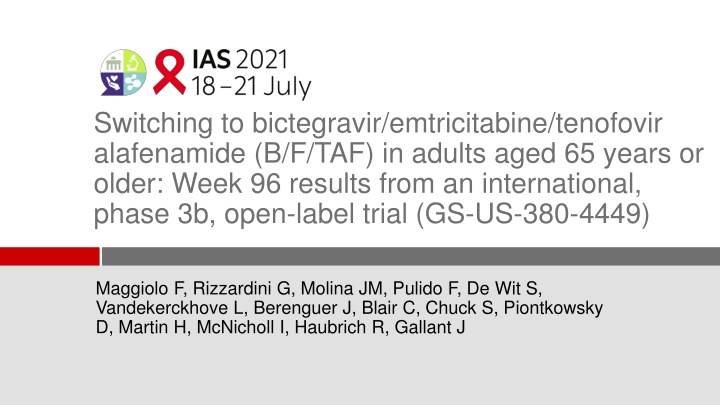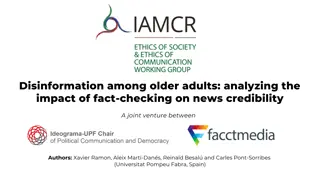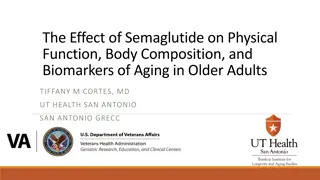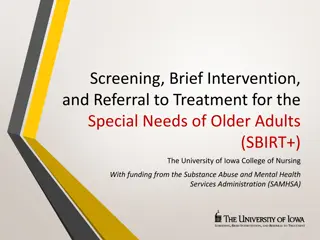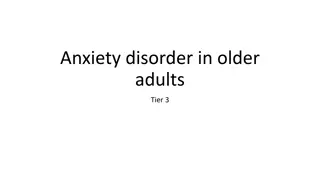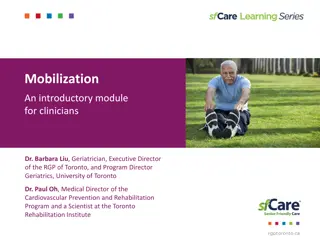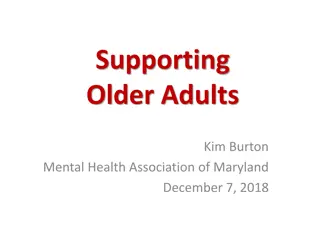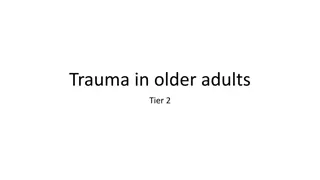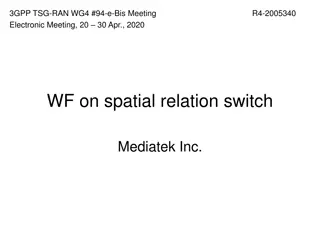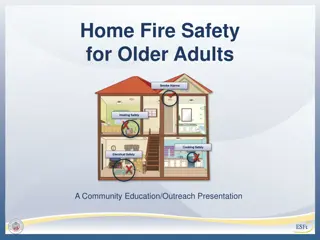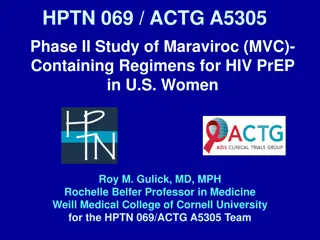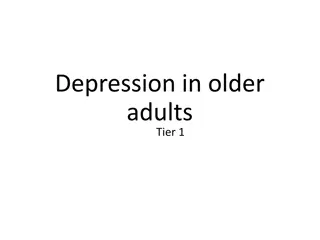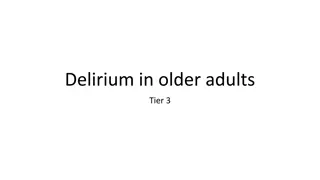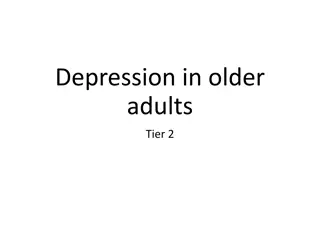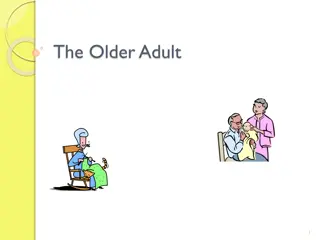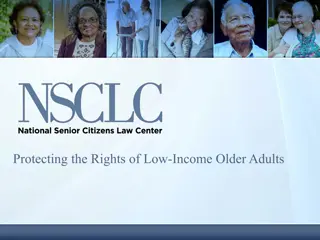Switching to Bictegravir/Emtricitabine/Tenofovir Alafenamide in Older Adults: Week 96 Results
Collecting data on the long-term safety of B/F/TAF regimen in older HIV patients is crucial due to increased co-morbidities and polypharmacy risks. This study presents Week 96 outcomes from an open-label trial, emphasizing the regimen's safety profile and efficacy through secondary endpoints. Baseline characteristics and key inclusion criteria reflect the importance of assessing ART tolerability in the elderly population.
Download Presentation

Please find below an Image/Link to download the presentation.
The content on the website is provided AS IS for your information and personal use only. It may not be sold, licensed, or shared on other websites without obtaining consent from the author.If you encounter any issues during the download, it is possible that the publisher has removed the file from their server.
You are allowed to download the files provided on this website for personal or commercial use, subject to the condition that they are used lawfully. All files are the property of their respective owners.
The content on the website is provided AS IS for your information and personal use only. It may not be sold, licensed, or shared on other websites without obtaining consent from the author.
E N D
Presentation Transcript
Switching to bictegravir/emtricitabine/tenofovir alafenamide (B/F/TAF) in adults aged 65 years or older: Week 96 results from an international, phase 3b, open-label trial (GS-US-380-4449) Maggiolo F, Rizzardini G, Molina JM, Pulido F, De Wit S, Vandekerckhove L, Berenguer J, Blair C, Chuck S, Piontkowsky D, Martin H, McNicholl I, Haubrich R, Gallant J
Background Because 50% of people living with HIV (PLWH) are > 50 years old, collecting and evaluating data on long term safety in older patients is important. Older PLWH are at increased risk of co-morbidities and polypharmacy, so ensuring the safety and tolerability of ART in this population is critical with regimens with lower drug-drug interaction potential. Declines in bone mineral density and renal function are or have been associated with aging; establishing the safety of TAF-based regimens in this population is important. B/F/TAF is a small single-tablet regimen with few drug-drug interactions and a high barrier to resistance. Tenofovir alafenamide (TAF) is a prodrug of tenofovir associated with 90% lower tenofovir plasma levels than tenofovir disoproxil fumarate (TDF), resulting in less renal and bone toxicity. 2
Study Design Multicenter, open-label, 96-week single arm HIV-infected Stable ART for 3 months Prior enrollment in E/C/F/TAF study 292-1826 or currently on E/C/F/TAF (or FTC/TDF + 3rd agent) N = 86 B/F/TAF 96 weeks 48 weeks Study sites in Belgium, France, Italy, Spain and the United Kingdom Primary endpoint: HIV RNA < 50 copies/mL at Week 24 by FDA Snapshot algorithm Secondary endpoints: HIV-1 RNA < 50 copies/mL at Weeks 48, 72 and 96 Safety and tolerability of B/F/TAF through 96 weeks 3
Key Inclusion Criteria Age 65 years at screening Currently receiving an antiretroviral regimen of E/C/F/TAF single tablet regimen (or FTC/TDF + 3rd agent if current or past participant in GS-US-292-1826) for 3 months* Documented plasma HIV-1 RNA < 50 copies/mL on current regimen for the last 2 visits preceding the Screening Visit Transient detectable viremia or blips (HIV-1 RNA 50 and < 400 copies/mL) were acceptable Estimated GFR 30 mL/min (Cockcroft-Gault formula) *Study GS-US-292-1826 was an international open label, randomized 48-week study of the efficacy and safety of switching from a TDF-based regimen to E/C/F/TAF in 167 participants 60 years and older 4
Baseline Demographics and Disease Characteristics B/F/TAF N=86 69 (65-80) 13% (11) Median age, years (range) Female, % (n) Race, % (n)* White 99% (82) Black 1% (1) Ethnicity, Hispanic/Latinx, % (n) 14% (12) Median weight (kg) (range) 78 (49-110) Median estimated GFRCG, mL/min (range) 76 (40-130) Mode of Infection, % (n) MSM 46.5% (40) Heterosexual 46.5% (40) * 3 participants did not disclose race 5
Baseline Demographics and Disease Characteristics (cont) B/F/TAF N=86 HIV RNA < 50 copies/mL at baseline, % (n) 98% (84) Median CD4 count, cells/mm3 (range) 676 (132-1385) Baseline Regimen, % (n)* EVG/COBI/FTC/TAF (E/C/F/TAF) 92% (79) RPV/FTC/TDF 5% (4) EFV/FTC/TDF 1% (1) EVG/COBI/FTC/TDF 1% (1) NVP+FTC/TDF 1% (1) * EVG-elvitegravir, COBI-cobicistat, FTC-emtricitabine, TAF-tenofovir alafenamide, RPV-rilpivirine, TDF-tenofovir disoproxil fumarate, NVP-nevirapine 6
Baseline Demographics and Disease Characteristics (cont) B/F/TAF N=86 3.0 (2, 5) Number of chronic non-ARV medications at baseline, median (IQR) Baseline number of chronic medications by organ-system class, % (n) Cardiovascular system 64% (55) Gastrointestinal tract 63% (54) Nervous system 44% (38) Blood and blood forming organs 27% (23) Musculoskeletal system 23% (20) Genitourinary system and sex hormones 21% (18) IQR-interquartile range 7
Virologic Outcomes at Week 96 (Snapshot Analysis) 100 Participants (%) 74 80 60 40 26 20 0 0 HIV-1 RNA <50 c/mL N=64 No Virologic Data HIV-1 RNA 50 c/mL N=0 N=22 No participant had an HIV-1 RNA 50 c/mL Median change in CD4 count was -3 cells/mm3 (IQR: -59, 91) at W96 (n=59) Due to the COVID-19 pandemic, 11 participants did not have data in the W96 window 8
Virologic Outcomes at Week 96 (M=E) 100 100 Participants (%) 80 60 40 20 0 0 HIV-1 RNA <50 c/mL N=68 HIV-1 RNA 50 c/mL N=0 Eleven participants did not have data due to the COVID-19 pandemic and restrictions on clinic/study visits; all were suppressed at their last visit. 9
Virologic Outcomes at Week 96 by FDA Snapshot B/F/TAF N=86 64 (74%) HIV-1 RNA < 50 c/mL HIV-1 RNA 50 c/mL HIV-1 RNA 50 c/mL in W96 Window DC Study Drug Due to Lack of Efficacy DC Study Drug Due to AE and Last Available HIV-1 RNA 50 c/mL DC Study Drug Due to Other Reasons and Last Available HIV-1 RNA 50 c/mL 0 0 0 0 0 No Virologic Data in W96 Window DC Study Drug Due to AE/Death and Last Available HIV-1 RNA < 50 c/mL DC Study Drug Due to Other Reasons and Last Available HIV-1 RNA < 50 c/mL Missing Data During Window but on Study Drug 22 (26%)* 7 (8%) 2 (2%) 13 (15%) * Eleven participants did not have data due to the COVID-19 pandemic and restrictions on clinic/study visits. 1) abdominal discomfort (grade 2, drug-related), 2) alcohol withdrawal, 3) benzodiazepine withdrawal, 4) depressive disorder, 5) weight increased (grade 3, drug-related) Of the 13 subjects: 2 subjects had Week 96 visit >1 day after the last dose and an HIV-1 RNA <50 c/mL, 11 subjects missed Week 96 and did not have HIV-1 RNA assessments after Week 84 though their Week 84 HIV-1 RNA <50 c/mL 10 c/mL=copies/mL, DC=discontinued
Treatment-Emergent Adverse Events through Week 96 B/F/TAF (n=86) % (n) 4.7% (4) Any Grades 2-4 Study Drug-Related AE Any Grades 3-4 Study Drug-Related AEs Grades 3 or 4 Laboratory Abnormalities Any Study Drug-Related Serious AE 2.3% (2) 13% (11) 0 AEs Leading to Study Drug Discontinuation AEs Leading to Study Drug Discontinuation (drug-related) Death 5.8% (5)* 3.5% (3) 2 There were no renal, bone or hepatic discontinuations *1) abdominal discomfort (grade 2, drug-related), 2) alcohol withdrawal, (grade 3), 3) benzodiazepine withdrawal (grade 2), 4) irritability and sleep disorder (grade 3, drug-related), 5) weight increased (grade 3, drug related) 1) 77 yo male with pre-existing depressive disorder led to suicide via a benzodiazepine overdose (study day 427), 2) 72 yo male developed pneumonia secondary to COVID-19 infection (study day 672); Neither death study drug-related 11
Weight: Median Change from Baseline through Week 96 5 Median (Q1, Q3) change 4 0 0 0 1.0 0.1 0 0 0 0 from Baseline (kg) 3 2 1 0 -1 -2 -3 -4 -5 0 4 12 24 36 48 Week 60 72 84 96 N= 86 86 84 84 82 79 83 81 80 67 Median change in weight at Week 96 was 0.0 kg (IQR -2.3, 2) 12
Renal Biomarker Changes (%) at Week 96 RBP:Cr 65 139.3 2m:Cr 64 72.0 N Baseline (ug/g) Median percent change (Q1, Q3) 250 200 150 100 50 0 -50 -16.4 18.7 8% of participants switched from a TDF-based regimen to B/F/TAF 13 *RBP:Cr, retinol-binding protein/creatinine; 2m:Cr, urine beta-2-microglobulin/creatinine
Estimated Glomerular Filtration Rate: Median Changes from Baseline through Week 96 Median (Q1, Q3) change from 5 0 Baseline (mL/min) -5 -10 -15 -20 0 4 12 24 36 48 60 72 84 96 Week N= 86 84 84 84 82 79 82 78 79 66 eGFRCG decline is consistent with known inhibition of OCT2 creatinine transporter eGFRCg, estimated glomerular filtration rate calculated with Cockcroft-Gault equation 14
Changes in Fasting Lipids at Week 96 B/F/TAF (N=56) Total LDL HDL Triglycerides Total Cholesterol:HDL Cholesterol Cholesterol Cholesterol 35 Median Change from 1 25 Baseline, mg/dL 15 0.5 5 -5 -1 0 -10 -15 -15 -19 -0.2 -25 -0.5 191 117 51 131 Baseline, mg/dL 3.9 Participants on lipid-modifying medication At baseline: 36 (42%) Initiated during study: 6 (7%) 15
Conclusion In this largest, international, Phase 3b study of virologically suppressed adults 65 years, switching to B/F/TAF was shown to be safe, effective and well tolerated through 96 weeks High virologic suppression when accounting for COVID-related study challenges with participant follow-up No virologic failures and no treatment-emergent resistance No renal, bone, or hepatic AEs resulting in discontinuation Few drug-related AEs leading to discontinuation No serious drug-related AEs eGFR decline consistent with known inhibition of OCT2 creatinine transporter Median weight stable Highly efficacious and well tolerated in the setting of co-morbidities and polypharmacy 16
Acknowledgments We extend our thanks to the participants, their partners and families, and all GS-US-380-4449 Investigators F Ajana, A Antinori, J Berenguer, JI Bernardino de la Serna, A Bonjoch, E Cua, S de Wit, A Di Biagio, G Di Perri, C Duvivier, PM Girard, E Lazaro, G Madeddu, F Maggiolo, J Mallolas Masferrer, GM Mateo Garc a, B Menzaghi, JM Molina, P Morlat, C Mussini, J Navarro, E Ong, G Parruti, B Payne, J Perez Stachowski, P Philibert, L Piroth, F Pulido, T Quirino, F Raffi, G Rizzardini, JD Ross, D Salmon-Ceron, L Vandekerckhove, L Waters This study was funded by Gilead Sciences, Inc. 17
